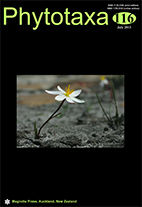Abstract
Mappia includes four species of trees and shrubs distributed in Central America, Mexico and the Greater Antilles. Mappia has historically been associated with the genera Casimirella (=Humirianthera), Icacina, Leretia and Nothapodytes, collectively comprising the Mappia complex, and over the years authors have merged or maintained these genera based on various lines of morphological and anatomical evidence. Here we present a phylogenetic study of the Mappia complex, based on morphological and molecular data, to assess monophyly of Mappia as well as relationships among other icacinaceous genera. Our results indicate that Mappia is sister to the Asiatic genus Nothapodytes, consistent with previous studies, and that Leretia, Icacina and Casimirella form a clade more closely related to other genera of Icacinaceae (e.g., Alsodeiopsis, Iodes, Phytocrene) than to Mappia+Nothapodytes. These results support recognition of Mappia as a distinct entity, and here we provide an updated taxonomic treatment for the genus, recognizing four species including three from Mexico and Central America (M. longipes, M. mexicana, and M. multiflora) and one from the Greater Antilles (M. racemosa).

